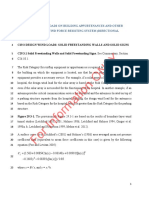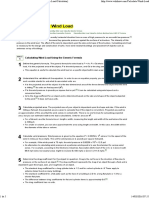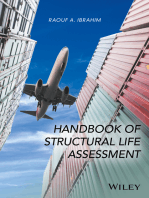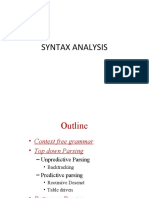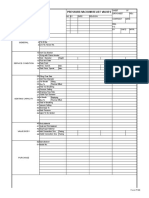Intercomparison of Wind-Driven Rain Models Based On A Case Study With Full-Scale Measurements
Intercomparison of Wind-Driven Rain Models Based On A Case Study With Full-Scale Measurements
Uploaded by
voldumvejCopyright:
Available Formats
Intercomparison of Wind-Driven Rain Models Based On A Case Study With Full-Scale Measurements
Intercomparison of Wind-Driven Rain Models Based On A Case Study With Full-Scale Measurements
Uploaded by
voldumvejOriginal Title
Copyright
Available Formats
Share this document
Did you find this document useful?
Is this content inappropriate?
Copyright:
Available Formats
Intercomparison of Wind-Driven Rain Models Based On A Case Study With Full-Scale Measurements
Intercomparison of Wind-Driven Rain Models Based On A Case Study With Full-Scale Measurements
Uploaded by
voldumvejCopyright:
Available Formats
The Fifth International Symposium on Computational Wind Engineering (CWE2010) Chapel Hill, North Carolina, USA May 23-27,
2010
Intercomparison of wind-driven rain models based on a case study with full-scale measurements
B. Blocken a, P.M. Briggen a, H.L. Schellen a, J. Carmeliet b,c
Building Physics and Systems, Eindhoven University of Technology, the Netherlands, b.j.e.blocken@tue.nl b Chair of Building Physics, Swiss Federal Institute of Technology ETHZ, Zrich, Switzerland c Laboratory for Building Technologies, Swiss Federal Laboratories for Materials Testing and Research, Empa, Dbendorf, Switzerland ABSTRACT: Three different calculation models for wind-driven rain (WDR) are compared: the semi-empirical model in the ISO standard for WDR (ISO), the semi-empirical model by Straube and Burnett (SB) and the CFD model by Choi, extended by Blocken and Carmeliet. This paper builds further on the comparison of these models for idealized building configurations and fixed wind and rain conditions in [Blocken et al., 2010. Comparison of calculation models for winddriven rain deposition on building facades, Atmospheric Environment 44(14): 1714-1725]. In the present paper, these models are applied to a high-rise monumental tower building, for a transient rain event, and the model results are compared with full-scale measurements. The agreement between the CFD results and the measurements is quite good at the upper part of the facade, while the ISO and SB model show large discrepancies at these facade positions. 1 INTRODUCTION Three different calculation models for wind-driven rain (WDR) on buildings are compared: the semi-empirical model in the ISO Standard for WDR (ISO, 2009), the semi-empirical model by Straube (1998) and Straube and Burnett (2000) and the CFD model by Choi (1991, 1993, 1994) that was extended into the time domain by Blocken and Carmeliet (2002, 2007). These models are referred to as ISO, SB and CFD, respectively. The theory of the models and a comparison of model performance by application to generic, idealized buildings were provided in earlier studies (Blocken and Carmeliet 2010; Blocken et al. 2010). In the present paper, the models are applied to determine the spatial and temporal distribution of WDR on the south-west facade of a real building for a real, transient rain event. This real building is the tower of the Hunting Lodge St. Hubertus, a monumental building in the national park De Hoge Veluwe in the Netherlands. 2 DESCRIPTION OF BUILDING, SURROUNDINGS AND MEASUREMENT SET-UP The Hunting Lodge St. Hubertus consists of a low-rise rectangular volume with wings that stretch out diagonally and with a characteristic tower in the middle of the building (Fig. 1; Briggen et al. 2009). The total building height is 34.5 m. From the fourth floor up, the tower is rectangular with dimensions 4.8 x 4.2 m2. There are no other buildings in the immediate vicinity, but the building is surrounded by a forest. There is an elongated clear-cut in the forest, SW of the building, with a length of about 600 m. The aerodynamic roughness length z0 of the forest is estimated 1 m, while that of the clear-cut is estimated 0.05 m. The measurement set-up consisted of
a
The Fifth International Symposium on Computational Wind Engineering (CWE2010) Chapel Hill, North Carolina, USA May 23-27, 2010
a meteorological mast positioned in such a way that it measured SW wind without disturbance by the building and the trees in its immediate vicinity (Briggen et al., 2009). The meteorological mast was equipped with an ultrasonic anemometer, providing the reference wind speed and wind direction at 10 m height: U10 and 10. Reference rainfall intensity Rh was measured by a rain gauge shielded by a wind screen. It was placed at the same location as the meteorological mast. WDR gauges (0.2 x 0.2 m catch area, made of sheet glass according to the WDR gauge design guidelines by Blocken and Carmeliet (2006a)) were installed at the tower facades (Fig. 1). Most gauges were positioned on the SW facade, because SW is the prevailing wind direction. All data were gathered on a 1-minute basis and afterwards averaged over 10-minute intervals. More information can be found in (Briggen et al., 2009).
Figure 1. (a) South-west facade of Hunting Lodge St. Hubertus and the positions and numbers of the wind-driven rain gauges (1-5), and of two additional positions without gauges (6-7) at the SW facade; (b) cross section A-A (indicated in Fig. 1a) of the building. Dimensions in meter.
3 WIND-DRIVEN RAIN MODELS 3.1 Model equations The input meteorological data consist of 10-minute values of U10, 10 and Rh. These hourly or 10minute intervals are called time steps. For the purpose of comparison, each model calculates the WDR intensity Rwdr for each time step by:
R wdr
= U 10 R
0.88 h
cos
(1)
where is the WDR coefficient and is the angle in a horizontal plane between the wind direction and the normal to the facade. Depending on the model, different expressions for have to be used (Blocken and Carmeliet, 2010). For wind perpendicular to the facade ( = 0), the WDR coefficient in the CFD model is:
R 0.12 h U 10
(2)
where is the catch ratio from the CFD simulation, which is defined as the ratio Rwdr/Rh. The WDR coefficient in the ISO model is:
The Fifth International Symposium on Computational Wind Engineering (CWE2010) Chapel Hill, North Carolina, USA May 23-27, 2010
2 CR CT O W 9
(3)
where CR is the roughness coefficient, CT the topography coefficient, O the obstruction factor and W the wall factor. CR takes into account the change of mean wind speed at the site due to the height above the ground and the upstream roughness of the terrain. It is given by:
z C R (z) = K R ln for z z min z 0
C R (z) = C R (z min ) for z < z min
(4)
where z is the height above ground, KR the terrain factor and zmin a minimum height. Values for these parameters are provided in the Standard (ISO, 2009). For example, for z0 = 0.01 m: KR = 0.17 and zmin = 2 m, and for z0 = 0.05 m: KR = 0.19 and zmin = 4 m. The topography coefficient takes into account the increase of mean wind speed over isolated hills and escarpments. The obstruction factor O takes into account the shelter of the wall by the nearest obstacle. The wall factor W tries to take into account the type of the wall (height, roof overhang) and the variation of WDR across the surface of the wall. Some values for W are shown in Figure 2a-c. The WDR coefficient in the SB model is:
z = DRF . RAF . R 0.12 h 10
(5)
Figure 2. (a-c) ISO wall factors (W) on the windward facade of a two-storey building with flat roof, a multi-storey building with flat roof and a two-storey eaves building (modified from ISO (2009)); (d-f) Contours of Straube and Burnetts rain admittance factor (RAF) on the windward facades of a wide low-rise building with flat roof, a highrise building and a low-rise building with pitched roof (Straube, 1998, Straube and Burnett, 2000).
The Fifth International Symposium on Computational Wind Engineering (CWE2010) Chapel Hill, North Carolina, USA May 23-27, 2010
where DRF is the driving rain function, RAF the rain admittance factor and the power-law exponent corresponding to the terrain roughness of the building site. The RAF is constant in time, while the DRF varies in time. RAF values have been published by Straube (1998) and Straube and Burnett (2000), but only for three types of buildings: see Figure 2d-f. The DRF is calculated as the inverse of the terminal velocity of fall Vt, given by the equation by Dingle and Lee (1972):
Vt (d ) =
0.166033 + 4.91844 d 0.888016 d + 0.054888 d 9.20 m/s
(6)
where d is the raindrop diameter. Concerning the choice of d, Straube and Burnett (2000) suggest the median diameter from the raindrop spectrum by Best (1950):
d = 1.105 R h 0.232
(7)
For each model, the WDR sum (Swdr in mm) for each time step is obtained by multiplying Rwdr with the time step length t. The accumulated (total) WDR at the end of the rain event is:
S wdr, tot
(R
wdr
t)
(8)
3.2 Main conclusions on model performance from previous studies The main conclusions from the previous comparison studies (Blocken and Carmeliet, 2010; Blocken et al., 2010) are summarized, below to support the analysis of model performance in this paper. The conclusions concern the ISO and SB model, when contrasted with the CFD model, which was shown to provide accurate results in validation studies (e.g. Blocken and Carmeliet, 2002, 2006b, Tang and Davidson, 2004, Abuku et al., 2009). 1 The ISO and SB model only provide information (factors W and RAF) for a few building types; 2 The ISO model does not take into account the variation of along the width of the facade; 3 Instead of providing a single value for the RAF, the SB model provides a minimum and maximum limit. For some facade positions, these values bound a wide range, which limits the predictive capability of this model; 4 In the SB model, the RAF values at the top edge and vertical edge of the facade are too large, and for low Rh, the dependency of the DRF on Rh is too strong; 5 The wind-blocking effect (Blocken and Carmeliet, 2006b) is not reproduced by the ISO and the SB model. The wind-blocking effect refers to the decrease of upstream streamwise wind speed, and therefore also of the WDR intensity, with an increase of the building scaling length (BSL):
BSL =
(B
BS
1 3
(9)
where BL is the larger and BS is the smaller dimension of the windward facade. The BSL was defined by Wilson (1989) for estimating the dimensions of flow recirculation regions on building roofs. 6. The increase of with increasing Rh can be reproduced by the CFD model. The ISO model does not predict this dependency, while the SB shows the opposite trend (decrease with increasing Rh).
The Fifth International Symposium on Computational Wind Engineering (CWE2010) Chapel Hill, North Carolina, USA May 23-27, 2010
4 MODEL APPLICATION 4.1 CFD model 3D steady RANS simulations with the realizable k- model (Shih et al., 1995) were performed with the commercial CFD code Fluent 6.3 by Briggen et al. (2009). The simulations were conducted following the CFD best practice guidelines by Franke et al. (2007) and Tominaga et al. (2008) and the recommendations by Blocken et al. (2007) for CFD simulation of neutral atmospheric boundary layer flow with this code. The simulation details, including the grid-sensitivity analysis, can be found in (Briggen et al., 2009). Simulations were only made for SW wind direction and for the SW facade ( = 0). The raindrop trajectories, specific catch ratio and catch ratio were all calculated with author-written program codes (Blocken and Carmeliet, 2006b). The raindrop-size distribution by Best (1950) was adopted. The simulations were made for U10 = 1, 2, 3, 5 and 10 m/s and for Rh = 0.1, 0.5, 1, 2, 3, 4, 5, 6, 8, 10, 12, 15, 20, 25 and 30 mm/h. and (Eq. 2) were calculated at every position at the west facade (resolution 0.08 x 0.08 m) for all the different combinations of U10 and Rh. These values for are used in Eq. (1), together with the meteorological data of the rain event, to determine the WDR intensity at different facade positions. The WDR intensities are converted to the accumulated WDR Swdr,tot by Eq. (8). 4.2 ISO model CR, CT and O are determined. CR is calculate using the parameters for terrain category II (ISO, 2009). CT and O are equal to one in this case. The wall factors are taken from Figure 2b for a multi-storey building, although the ISO standard does not provide wall factors for a facade that is triangular at the top (Figure 1a). 4.3 Model by Straube and Burnett The RAF values are taken from Figure 2e, which seems appropriate, because H >> W applies for the tower. However, these values are strictly not applicable for positions 6 and 7, situated at the triangular part of the facade. The value of that corresponds to terrain category II in the ISO model is 0.16. 4.4 Comparison of temporal distribution of wind-driven rain The rain event is shown in Figure 3a. It is characterized by a series of individual showers. Wind speed is on average 1.3 m/s and wind direction during rain is only slightly oblique to the SW facade ( 0). Rh ranges from 0 to 4.5 mm/h, and is on average equal to 1.2 mm/h (zero Rh values excluded). Figure 3b shows the measured and calculated temporal distribution of WDR at position 3. A conservative measurement error estimate is Ewdr = 0.2 mm (Briggen et al., 2009). All models qualitatively reproduce the temporal variation. Quantitatively, CFD somewhat underestimates the measured values. ISO provides an estimate that is about four times too low, while SBmin is larger than both the measurements and the CFD results. Figure 3c shows the temporal variation of at the same position, and Figure 3d shows the variation with U10 and Rh at position 3. Note that the overall differences between CFD on one hand, and ISO and SBmax and SBmin on the other hand, are very large. The reason for this is discussed in the next section. 4.5 Comparison of spatial distribution of wind-driven rain Figure 4 compares measurements and calculations at the end of the rain event, at the positions of the WDR gauges (1-5) and at two additional positions near the top of the facade (6-7).
The Fifth International Symposium on Computational Wind Engineering (CWE2010) Chapel Hill, North Carolina, USA May 23-27, 2010
ISO
ISO
Figure 3. (a) Meteorological data record (10-minute data); (b) Temporal distribution of cumulative wind-driven rain at position 3 from experiments and CFD, ISO and SB models; (c) Temporal distribution of wind-driven rain coefficient at position 3 for CFD, ISO and SB models; (d) Variation of at position 3 with U10 and Rh according to CFD and SB model.
A conservative estimate for the error in the measured ratios is ewdr = 0.02. The observations are: 1 Figure 4a: the measured ratios increase from bottom to top, and from the middle of the facade to the sides. The value at position 5 is slightly higher than at position 3, because the wind direction is a bit lower than 225 (= south-west). Data at position 2 are not available due to equipment malfunctioning. 2 Figure 4b: the CFD results also show the increase with height and from the middle to the sides. The agreement between CFD simulations and measurements is good, except at position 1. As mentioned by Briggen et al. (2009), this can be attributed to turbulent dispersion, which can have a significant effect in regions where the raindrop trajectories are almost parallel to the facade, which is the case at the lower part of high-rise buildings, such as near position 1. 3 Figure 4c: the results by the ISO model are up to four times smaller than the measurements. The same observation was made in Figure 3b. This poor performance appears to be in contradiction to the quite good performance by the ISO model for two idealized high-rise buildings in an earlier study (Blocken et al., 2010). The reason for this different performance is the wind-blocking effect (see statement nr. 5 in section 3.2). This effect is present in reality but not reproduced by the ISO model (Blocken et al., 2010). The larger the wind-blocking effect, the lower the WDR exposure of the facade. In the previous study, the BSL values were 50 m
The Fifth International Symposium on Computational Wind Engineering (CWE2010) Chapel Hill, North Carolina, USA May 23-27, 2010
and 31.7 m, while in the present study (when neglecting the wider bottom part of the building), the BSL is only 9.3 m. As a result, the actual WDR coefficients at this tower are much higher. Comparing CFD WDR coefficients has indeed shown that those for the present tower are about two to three times larger than those for the buildings in the previous study. The ISO model does not take the wind-blocking effect into account. Therefore, while it provides fairly good results for the high-rise buildings with BSL equal to 31.7 m and 50 m, it provides large underestimations for BSL = 9.3 m. 4 Figure 4d-e: SBmin and SBmax show the increase of WDR exposure with height and from the middle of the facade to the sides. Just like the ISO model, also the SB model does not take the wind-blocking effect into account. This could cause this model to also underestimate the WDR exposure. However, the SB model in general provides RAF values that are (much) too large in the vicinity of the top and side edges of high-rise buildings with rectangular facades (see statement 4 in section 3.2). These two effects compensate each other to some extent, but in spite of this, SBmin still overestimates the measurements at positions 3, 4 and 5. It also overestimates the CFD results at these positions. On the other hand, it does not overestimate the CFD values at positions 6 and 7. The reason is that these positions are in reality much more exposed, as the top of the facade is triangular (less wind-blocking) instead of rectangular. This causes a very high WDR exposure, as shown by the CFD results. The CFD value at the top is even larger than the value by SBmax. Note however, that strictly, the SB model does not provide wall factors for such positions at the top of triangular facades.
Fig. 4. Experimental and calculation results at end of the rain event in Figure 3a: spatial distribution of ratio of accumulated wind-driven rain to accumulated horizontal rainfall.
5 CONCLUSIONS Three calculation models for wind-driven rain (WDR) have been compared by application to a real building and for a transient rain event: the ISO Standard for WDR (ISO), the Straube and Burnett model (SB) and the CFD model by Choi, extended by Blocken and Carmeliet (CFD). The main conclusions of the comparison are: 1 The agreement between measurements and CFD is quite good at the upper part of the building, while the discrepancies between the measurements and the ISO and SB models are large.
The Fifth International Symposium on Computational Wind Engineering (CWE2010) Chapel Hill, North Carolina, USA May 23-27, 2010
2 These discrepancies can be explained based on the six main conclusions from two previous studies. The main reasons however are the wind-blocking effect, which is reproduced by CFD but not by the ISO and SB models, and the fact that the SB model strongly overestimates the RAF at vertical and top edges of buildings. 3 The capabilities and deficiencies of the ISO and SB model, as identified in this paper, should be considered when applying these models for WDR deposition calculations. 6 REFERENCES
Abuku M., Blocken B., Nore K., Thue J.V., Carmeliet J., Roels S., 2009. On the validity of numerical wind-driven rain simulation on a rectangular low-rise building under various oblique winds. Building and Environment 44, 621 632. Best, A.C., 1950. The size distribution of raindrops, Quarterly Journal of the Royal Meteorological Society 76, 16-36. Blocken, B., Carmeliet, J. 2002. Spatial and temporal distribution of driving rain on a low-rise building, Wind and Structures 5(5), 441-462. Blocken, B., Carmeliet, J. 2006a. On the accuracy of wind-driven rain measurements on buildings, Building and Environment 41(12), 1798-1810. Blocken, B., Carmeliet, J. 2006b. The influence of the wind-blocking effect by a building on its wind-driven rain exposure, Journal of Wind Engineering and Industrial Aerodynamics 94(2), 101-127. Blocken, B., Carmeliet, J. 2007. On the errors associated with the use of hourly data in wind-driven rain calculations on building facades. Atmospheric Environment 41(11), 2335-2343. Blocken, B., Stathopoulos, T., Carmeliet, J. 2007. CFD simulation of the atmospheric boundary layer: wall function problems, Atmospheric Environment 41(2), 238-252. Blocken B., Carmeliet J., 2008. Guidelines for the required time resolution of meteorological input data for winddriven rain calculations on buildings. Journal of Wind Engineering and Industrial Aerodynamics 96(5), 621-639. Blocken B., Carmeliet J., 2010. Overview of three state-of-the-art wind-driven rain assessment models and comparison based on model theory. Building and Environment 45(3), 691-703. Blocken, B., Desz, G., van Beeck, J., Carmeliet, J. 2010. Comparison of calculation methods for wind-driven rain deposition on building facades. Atmospheric Environment 44(14), 1714-1725. Briggen, P.M., Blocken, B., Schellen, H.L. 2009. Wind-driven rain on the facade of a monumental tower: numerical simulation, full-scale validation and sensitivity analysis, Building and Environment 44(8), 16751690. Choi E.C.C., 1991. Numerical simulation of wind-driven-rain falling onto a 2-D building. Proceedings of Asia Pacific Conference on Computational Mechanics, Hong Kong, 1721-1728. Choi, E.C.C., 1993. Simulation of wind-driven rain around a building. Journal of Wind Engineering and Industrial Aerodynamics 46&47, 721-729. Choi, E.C.C. 1994. Determination of wind-driven rain intensity on building faces. Journal of Wind Engineering and Industrial Aerodynamics 51, 55-69. Dingle AN, Lee Y. Terminal fall speeds of raindrops. Journal of Applied Meteorology 1972; 11: 877-879. Franke, J., Hellsten, A., Schlnzen, H., Carissimo, B. 2007. Best practice guideline for the CFD simulation of flows in the urban environment. COST 732: Quality Assurance and Improvement of Microscale Meteorol. Models. ISO, 2009. Hygrothermal performance of buildings Calculation and presentation of climatic data Part 3: Calculation of a driving rain index for vertical surfaces from hourly wind and rain data. ISO 15927-3:2009. Shih, T.H., Liou, W.W., Shabbir, A., Zhu, J. 1995. A new k- eddy-viscosity model for high Reynolds number turbulent flows model development and validation, Computers & Fluids 24(3), 227-238. Straube, J.F. 1998. Moisture control and enclosure wall systems, Ph.D. thesis, Civil Engineering, University of Waterloo, Ontario, Canada, 318 p. Straube, J.F., Burnett, E.F.P. 2000. Simplified prediction of driving rain on buildings, Proc. of the International Building Physics Conf., Eindhoven, The Netherlands, 18-21 September 2000, 375-382. Tang W., Davidson C.I., 2004. Erosion of limestone building surfaces caused by wind-driven rain. 2. Numerical modelling. Atmospheric Environment 38(33), 5601-5609. Tominaga, Y., Mochida, A., Yoshie, R., Kataoka, H., Nozu, T., Yoshikawa, M., Shirasawa, T. 2008. AIJ guidelines for practical applications of CFD to pedestrian wind environment around buildings. Journal of Wind Engineering and Industrial Aerodynamics 96(10-11), 1749-1761. Wilson D.J., 1989. Airflow around buildings, ASHRAE Handbook of Fundamentals, pp. 14.1-14.18.
You might also like
- 2 Materials Development Who Should DevelopedDocument7 pages2 Materials Development Who Should DevelopedIMELDA TORRESNo ratings yet
- Tenses Konu AnlatimiDocument6 pagesTenses Konu Anlatimikl67% (3)
- Kubilay2015 PDFDocument18 pagesKubilay2015 PDFBorisBerezovsky100% (1)
- Design Wind Force Coefficients For Hyperbolic Paraboloid Free RoofsDocument19 pagesDesign Wind Force Coefficients For Hyperbolic Paraboloid Free RoofsPhysicaldavidNo ratings yet
- Reddy Jaiswal Godbole Wind and Earthquake Analysis of Tall RC Chimneys 2011 571Document4 pagesReddy Jaiswal Godbole Wind and Earthquake Analysis of Tall RC Chimneys 2011 571Jhonatan SQNo ratings yet
- Bs2019 Paper IVDocument7 pagesBs2019 Paper IVdcpctrexNo ratings yet
- A Calibrationmethodfordownwindwakemodelsaccounting PDFDocument10 pagesA Calibrationmethodfordownwindwakemodelsaccounting PDFScott TuckerNo ratings yet
- Jeas 0112 628Document7 pagesJeas 0112 628DharaneshskumarNo ratings yet
- Asce 7-22 CH 29com - For PCDocument22 pagesAsce 7-22 CH 29com - For PCsharethefilesNo ratings yet
- Norma Japonesa Aij-Rlb-1996Document36 pagesNorma Japonesa Aij-Rlb-1996AnaApcarianNo ratings yet
- A Computer-Assisted Wind Load Evaluation System For The Design of Cladding of Buildings: A Case Study of Spatial StructuresDocument19 pagesA Computer-Assisted Wind Load Evaluation System For The Design of Cladding of Buildings: A Case Study of Spatial StructuresMoonzeNo ratings yet
- DR Seifu Bekele ACSEVSeminar2013 PresentationDocument44 pagesDR Seifu Bekele ACSEVSeminar2013 PresentationbenNo ratings yet
- Prediction and Reduction of Noise From A 2.3 MW Wind TurbineDocument10 pagesPrediction and Reduction of Noise From A 2.3 MW Wind TurbineJennyfer GalindezNo ratings yet
- Analysis of Wind Loads Acting On Large Span Double-Arched Roof Structure With Opening EndsDocument4 pagesAnalysis of Wind Loads Acting On Large Span Double-Arched Roof Structure With Opening EndsKhắc ĐăngNo ratings yet
- Aerodynamic Loads On Solar Panels (Simulation Results)Document10 pagesAerodynamic Loads On Solar Panels (Simulation Results)vijayNo ratings yet
- H MontazeriDocument8 pagesH MontazeriRaúl SánchezNo ratings yet
- Chinese Country Report 2012 - Revision of Wind Loading Code and Wind Tunnel Test GuidelinesDocument9 pagesChinese Country Report 2012 - Revision of Wind Loading Code and Wind Tunnel Test GuidelinesSanthosh Kumar BaswaNo ratings yet
- Wind Analysis of TowerDocument5 pagesWind Analysis of Towerar4indNo ratings yet
- The Use of Wind Tunnel Measurements in Building Design: July 2011Document21 pagesThe Use of Wind Tunnel Measurements in Building Design: July 2011JoseAngelFernandezOrtegaNo ratings yet
- Effects of Corner Cuts and Angles of Attack On The Strouhal Number of Rectangular CylindersDocument15 pagesEffects of Corner Cuts and Angles of Attack On The Strouhal Number of Rectangular Cylindersvikram vilasNo ratings yet
- Design of A Lattice Wind Tower and A Comparison of The Structural Response With and Without A TMDDocument23 pagesDesign of A Lattice Wind Tower and A Comparison of The Structural Response With and Without A TMDkarlrossmannNo ratings yet
- STANFIELD, CAMMELLI AND WOOD - Stadia and Arenas - Aerodynamics and BeyondDocument8 pagesSTANFIELD, CAMMELLI AND WOOD - Stadia and Arenas - Aerodynamics and BeyondRobin StanfieldNo ratings yet
- 1 s2.0 S016761050800024X MainDocument11 pages1 s2.0 S016761050800024X MainAof KaninNo ratings yet
- Analysis of Coupled Shear Wall Under The Effect of Wind Load - A Simplified Solved ExampleDocument9 pagesAnalysis of Coupled Shear Wall Under The Effect of Wind Load - A Simplified Solved ExamplederdushaNo ratings yet
- Wind Load For CubaDocument7 pagesWind Load For Cubaberto2008No ratings yet
- Emes-Rev Heliostat Wind Load (2021)Document23 pagesEmes-Rev Heliostat Wind Load (2021)Nicolas SotoNo ratings yet
- C 7 06barros Proof ApprovDocument42 pagesC 7 06barros Proof ApprovVIETCONS SOFTNo ratings yet
- Comparative Study of Wind-Induced Accelerations in Tall Timber Buildings According To Four MethodsDocument10 pagesComparative Study of Wind-Induced Accelerations in Tall Timber Buildings According To Four MethodslumoshaozeNo ratings yet
- Como Calcular Carga Do Vento (How To Calculate Wind Load)Document5 pagesComo Calcular Carga Do Vento (How To Calculate Wind Load)Fábio LessaNo ratings yet
- Wind Action According To The Brazilian Code: A Case Study: 1 A.M.Wahrhaftig, 2 R.M.L.R.F. BrasilDocument12 pagesWind Action According To The Brazilian Code: A Case Study: 1 A.M.Wahrhaftig, 2 R.M.L.R.F. BrasilRANGAMALLIGA6941No ratings yet
- Wind Is A Mass of Air That Moves in A Mostly Horizontal Direction From An Area of High Pressure To An Area With Low PressureDocument10 pagesWind Is A Mass of Air That Moves in A Mostly Horizontal Direction From An Area of High Pressure To An Area With Low Pressurehimanshu tonkNo ratings yet
- Wind Effects On Photovoltaic (PV) Panels - A CFD ApproachDocument3 pagesWind Effects On Photovoltaic (PV) Panels - A CFD ApproachghadasaudiNo ratings yet
- Wind Tunnel Methods2Document21 pagesWind Tunnel Methods2mdkml2100% (1)
- 4 Ways To Calculate Wind Load - WikihowDocument8 pages4 Ways To Calculate Wind Load - WikihowMAYANK CHAUHANNo ratings yet
- Use of Computational Fluid Dynamics in Civil EngineeringDocument14 pagesUse of Computational Fluid Dynamics in Civil EngineeringAnonymous TqP3LLNuuNo ratings yet
- Mai NextDocument16 pagesMai Next余辉No ratings yet
- ASCE 7-22 CH 29com - For PC - SouDocument23 pagesASCE 7-22 CH 29com - For PC - SousharethefilesNo ratings yet
- Across Wind Loads of Typical Tall BuildingsDocument19 pagesAcross Wind Loads of Typical Tall BuildingsBianca ParvNo ratings yet
- Building Down WashDocument31 pagesBuilding Down WashKhairun Nisa AnwarNo ratings yet
- Wind Pressure Acting On Flat Roofed Buildings: X.K. Jing, Y.Q. LiDocument8 pagesWind Pressure Acting On Flat Roofed Buildings: X.K. Jing, Y.Q. LiEng TrNo ratings yet
- Improving Pedestrian Wind Comfort Around A High Rise Building in An Urban AreaDocument8 pagesImproving Pedestrian Wind Comfort Around A High Rise Building in An Urban AreaEnrico NardiNo ratings yet
- Udell 2010 Low Costmountingarrangementsforbuilding IntegratedwindturbinesDocument13 pagesUdell 2010 Low Costmountingarrangementsforbuilding IntegratedwindturbinesFernandoNo ratings yet
- Compatible Acceleration and Displacement Spectra For Seismic Design CodesDocument8 pagesCompatible Acceleration and Displacement Spectra For Seismic Design CodeskvvrajkumarNo ratings yet
- The Best Ways To Calculate Wind Load - WikiHowDocument5 pagesThe Best Ways To Calculate Wind Load - WikiHowsreedharNo ratings yet
- Power Law PVHDocument9 pagesPower Law PVHNarasimha DvlNo ratings yet
- Numerical Modelling of Velocity Profile ParametersDocument11 pagesNumerical Modelling of Velocity Profile ParametersMarek OtrebaNo ratings yet
- WIND LOADS ON FILM PLASTIC GREENHOUSES Hoxey1983Document13 pagesWIND LOADS ON FILM PLASTIC GREENHOUSES Hoxey1983Victor CeballosNo ratings yet
- Design of Buildings Windloads ProfHaefnerDocument9 pagesDesign of Buildings Windloads ProfHaefnerVianda KauriviNo ratings yet
- Seismic Isolation With A New Friction-Viscoelastic Damping SystemDocument13 pagesSeismic Isolation With A New Friction-Viscoelastic Damping SystemAngga Fajar SetiawanNo ratings yet
- Wind Loading On Solar Panels at Different Inclination AnglesDocument9 pagesWind Loading On Solar Panels at Different Inclination AnglesPauloAndresSepulvedaNo ratings yet
- Rain NoiseDocument10 pagesRain NoisedeepscubNo ratings yet
- AbhilashDocument5 pagesAbhilashEswaran MuthaiahNo ratings yet
- Solar Radiation Model: L.T. Wong, W.K. ChowDocument34 pagesSolar Radiation Model: L.T. Wong, W.K. ChowSubhash ChandNo ratings yet
- AUSWind LoadDocument6 pagesAUSWind Loadأزيزى سودينNo ratings yet
- GueymardThevenard RevisingClimaticDataPartII ASHRAE13pDocument20 pagesGueymardThevenard RevisingClimaticDataPartII ASHRAE13ppaween saetaeNo ratings yet
- ViewDocument12 pagesViewMOHAMED SHARKAWINo ratings yet
- Mypaper ICAMEDocument6 pagesMypaper ICAMEKaoutar BenamorNo ratings yet
- 0 - Actions On Structures Wind Loads - CIB ReportDocument100 pages0 - Actions On Structures Wind Loads - CIB ReportWilliam PolNo ratings yet
- 1) OpenFoam - Blocken - O132 - 0087 - Toparlar - EtalDocument8 pages1) OpenFoam - Blocken - O132 - 0087 - Toparlar - EtalBai HuNo ratings yet
- Topic 6Document11 pagesTopic 6stefanNo ratings yet
- Syntax AnalysisDocument87 pagesSyntax AnalysisSaif UllahNo ratings yet
- PID Theory ExplainedDocument9 pagesPID Theory ExplainedMansen NsubugaNo ratings yet
- Drilling Power SystemDocument22 pagesDrilling Power Systemavula43100% (2)
- Electrical Fundamentals Chapter 1Document1 pageElectrical Fundamentals Chapter 1Karim KadmaniNo ratings yet
- The Most Valuable Metal in The World: Miranda Febriani Tanjung 1810411022Document1 pageThe Most Valuable Metal in The World: Miranda Febriani Tanjung 1810411022Miranda Febriani TanjungNo ratings yet
- Determination of Contact Parameters of Au-n-Ge Schottky Barrier Diode With Rubrene InterlayerDocument9 pagesDetermination of Contact Parameters of Au-n-Ge Schottky Barrier Diode With Rubrene InterlayerbhaktimayshreyasNo ratings yet
- Think Slow or Think FastDocument17 pagesThink Slow or Think FastDinda Putri AmaliaNo ratings yet
- SERVICE MANUAL FOR SECA 766,767 (17-05-01-309-A)Document39 pagesSERVICE MANUAL FOR SECA 766,767 (17-05-01-309-A)Pañares Neil100% (3)
- Bosch Serie-6 Waq283s1gb 209 58300000178575 Ara Washing MachineDocument70 pagesBosch Serie-6 Waq283s1gb 209 58300000178575 Ara Washing MachineinternetovsNo ratings yet
- The Simulation Meteor Shower LED Based On W79E2051 OneDocument2 pagesThe Simulation Meteor Shower LED Based On W79E2051 OneLaurentiu IacobNo ratings yet
- User Manual 2 2946010Document25 pagesUser Manual 2 2946010ivancalderon867374No ratings yet
- Extra Grammar Exercises (Unit 9, Page 100) LESSON 1 Modals Should and CouldDocument2 pagesExtra Grammar Exercises (Unit 9, Page 100) LESSON 1 Modals Should and CouldEsteban ArtucsNo ratings yet
- MC PT-Injection Brochure UK 07-2013 ScreenDocument40 pagesMC PT-Injection Brochure UK 07-2013 Screenpetronela.12No ratings yet
- Honcha QT6 16 PDFDocument7 pagesHoncha QT6 16 PDFSuhendra Amka PutraNo ratings yet
- SOI Lateral Hall Device With Deep Trench Fingers For High Sensitivity and Low OffsetDocument4 pagesSOI Lateral Hall Device With Deep Trench Fingers For High Sensitivity and Low OffsetMitchell LeeNo ratings yet
- Performance Myth: HR AssignmentDocument13 pagesPerformance Myth: HR AssignmentVedika KhetanNo ratings yet
- Ayurvedic BiologyDocument5 pagesAyurvedic BiologyPrem KumarNo ratings yet
- 3 Free-Energy Devices - Motionless Pulsed SystemsDocument159 pages3 Free-Energy Devices - Motionless Pulsed SystemsGoran Štetin100% (2)
- tgv4m Three-Act Structure Assign Rubric Single PointDocument1 pagetgv4m Three-Act Structure Assign Rubric Single Pointapi-251973159No ratings yet
- Public Transport System CHAPTERDocument66 pagesPublic Transport System CHAPTERfritzgeraldmacuhaNo ratings yet
- Questions: We Are All Friends NowDocument67 pagesQuestions: We Are All Friends NowAmirjon IsmatilloyevNo ratings yet
- Use of Waste Materials in Hotm Mix Asphalt STP1193-EB.20405 PDFDocument304 pagesUse of Waste Materials in Hotm Mix Asphalt STP1193-EB.20405 PDFSri RamyaNo ratings yet
- Journal of Environmental Chemical Engineering: SciencedirectDocument9 pagesJournal of Environmental Chemical Engineering: SciencedirectLeynard NatividadNo ratings yet
- Final LAS Science 10 Q2 W1Document11 pagesFinal LAS Science 10 Q2 W1Melogen LabradorNo ratings yet
- Pressure/Vacuum Relief Valves: Client Project Location Unit 1 2 3 4Document4 pagesPressure/Vacuum Relief Valves: Client Project Location Unit 1 2 3 4Jorge RodríguezNo ratings yet
- Revised BOQ ElectricalDocument37 pagesRevised BOQ ElectricalAbdallah ElabassyNo ratings yet
- Geography Grade 11 Relab Learner GuideDocument125 pagesGeography Grade 11 Relab Learner Guidemabuzanontokozo72No ratings yet
- Marine Inland Transit Clause WordingDocument8 pagesMarine Inland Transit Clause WordingRaviTeja KvsnNo ratings yet








